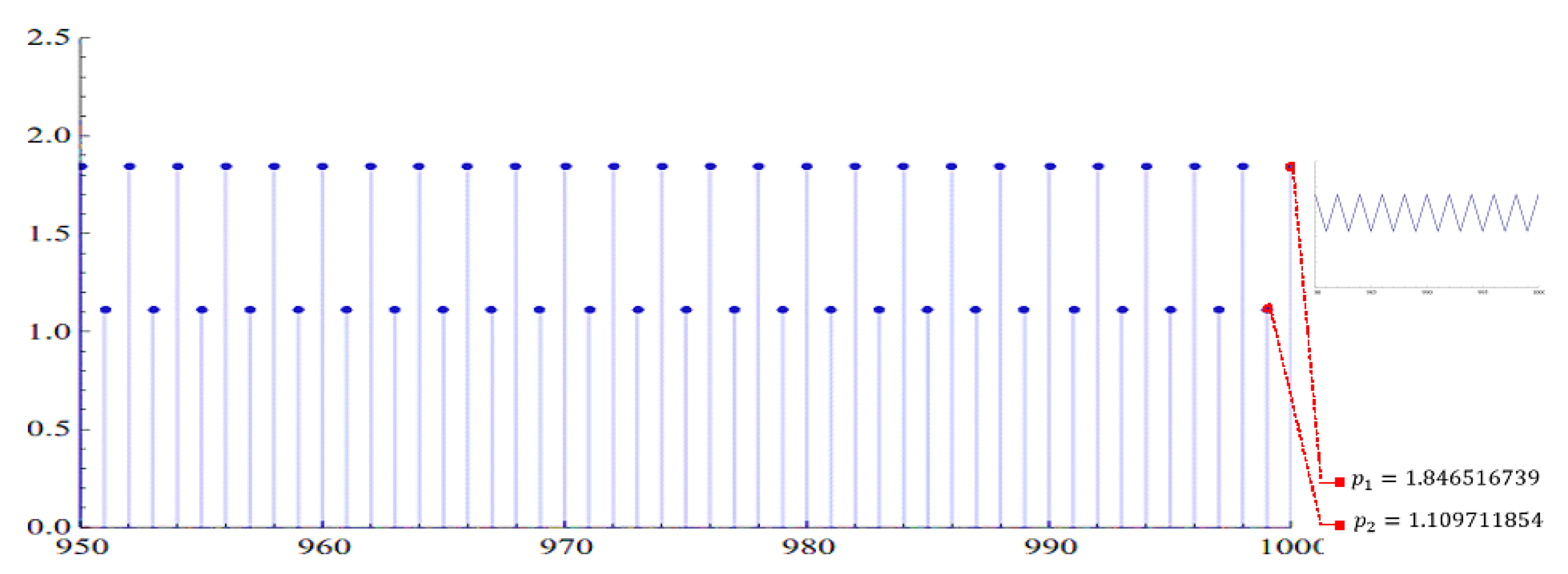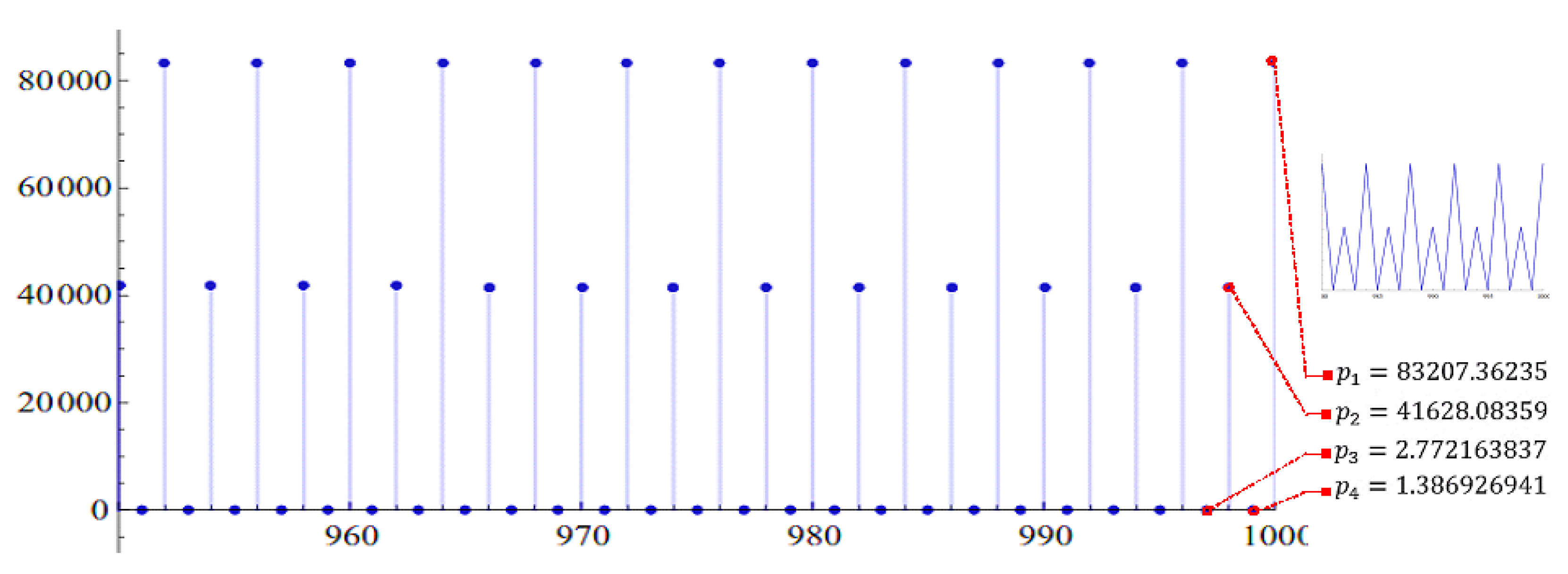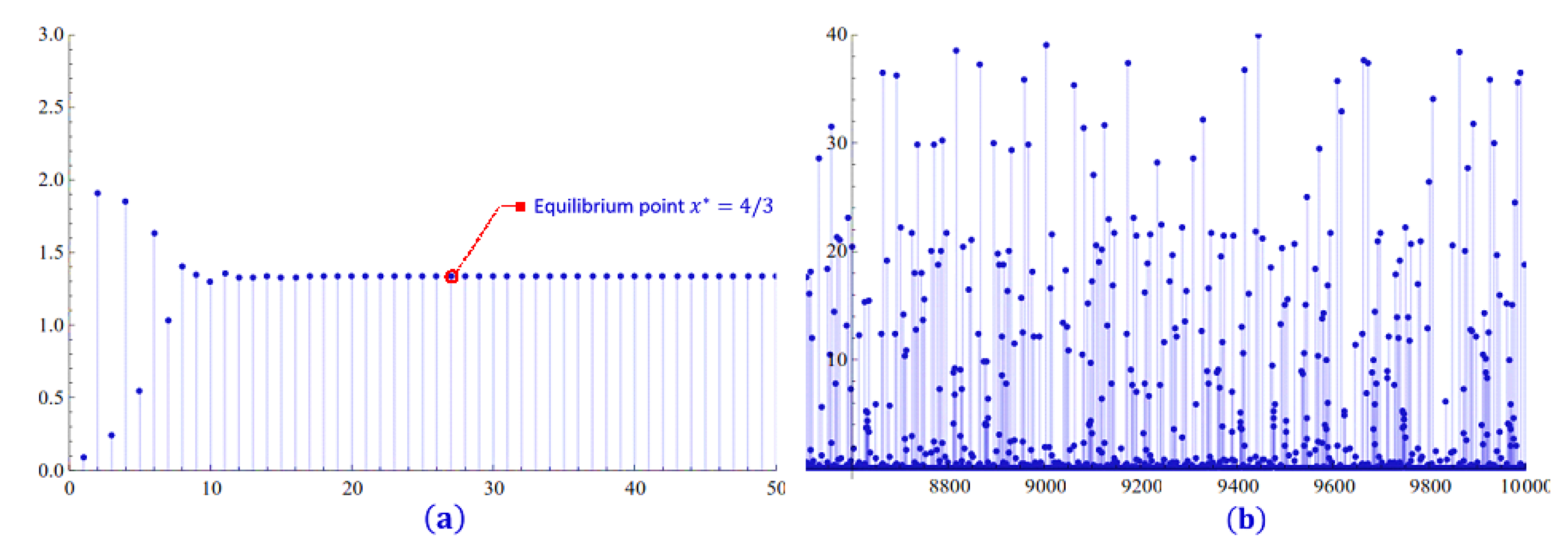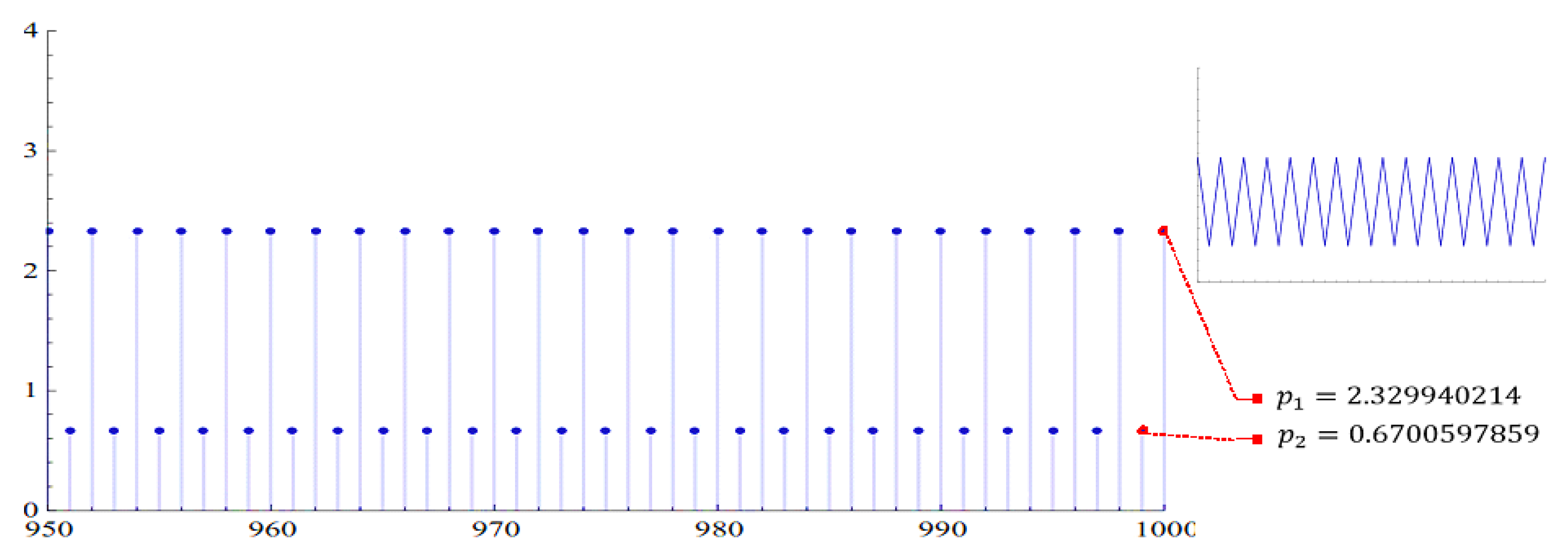Dynamics of General Class of Difference Equations and Population Model with Two Age Classes
Abstract
1. Introduction
- (a)
- If and , then is locally asymptotically stable;
- (b)
- If either or , then is unstable;
- (c)
- The point is locally asymptotically stable and sink if and only if halds and ;
- (d)
- The point is a repeller, that is and , if and only if and ;
- (e)
- The point is a saddle point, that is only one of and is holds, if and only is and ;
- (f)
- The point is a nonhyperbolic point, that is either or , if and only if or and .
2. Dynamics of Equation (4)
2.1. Stability and Boundedness of Equation (4)
- (1)
- If then is locally asymptotically stable and sink;
- (2)
- If then is unstable and repeller;
- (3)
- If then is nonhyperbolic point.
- (1)
- Equilibrium point is locally asymptotically stable and sink if and only if
- (2)
- Equilibrium point is unstable saddle point if and only if
- (3)
- Equilibrium point is unstable and repeller if and only if , or
- (4)
- Equilibrium point is nonhyperbolic point if and only if , orwhere and .
2.2. The Existence of Periodic Solutions
3. A Population Model
- 1.
- Equilibrium point is locally asymptotically stable and sink if and only if .
- 2.
- Equilibrium point is unstable saddle point if and only if .
- 3.
- Equilibrium point is unstable and repeller if and only if and .
- 4.
- Equilibrium point is nonhyperbolic point if and only if , or and .
4. Numerical Examples
5. Conclusions
Author Contributions
Funding
Acknowledgments
Conflicts of Interest
References
- Ahmad, S. On the nonautonomous Volterra-Lotka competition equations. Proc. Am. Math. Soc. 1993, 117, 199–204. [Google Scholar] [CrossRef]
- Allman, E.S.; Rhodes, J.A. Mathematical Models in Biology: An Introduction; Cambridge University Press: Cambridge, UK, 2003. [Google Scholar]
- Din, Q.; Elsayed, E.M. Stability analysis of a discrete ecological model. Comput. Ecol. Softw. 2014, 4, 89–103. [Google Scholar]
- Elettreby, M.F.; El-Metwally, H. On a system of difference equations of an economic model. Discr. Dyn. Nat. Soc. 2013, 6, 405628. [Google Scholar] [CrossRef][Green Version]
- Haghighi, A.M.; Mishev, D.P. Difference and Differential Equations with Applications in Queueing Theory; John Wiley & Sons Inc.: Hoboken, NJ, USA, 2013. [Google Scholar]
- Kelley, W.G.; Peterson, A.C. Difference Equations: An Introduction with Applications, 2nd ed.; Harcour Academic: New York, NY, USA, 2001. [Google Scholar]
- Liu, X. A note on the existence of periodic solutions in discrete predator-prey models. Appl. Math. Model. 2010, 34, 2477–2483. [Google Scholar] [CrossRef]
- Zhou, Z.; Zou, X. Stable periodic solutions in a discrete periodic logistic equation. Appl. Math. Lett. 2003, 16, 165–171. [Google Scholar] [CrossRef]
- Cull, P.; Flahive, M.; Robson, R. Difference equations: From rabbits to chaos. In Undergraduate Texts in Mathematics; Springer: New York, NY, USA, 2005. [Google Scholar]
- Beverton, R.J.H.; Holt, S.J. On the Dynamics of Exploited Fish Populations; Fishery Investigations Series II; Blackburn Press: Caldwell, NJ, USA, 2004; Volume 19. [Google Scholar]
- May, R.M. Nonlinear problems in ecology and resource management. In Chaotic Behaviour of Deterministic Systems; Helleman, R.H.G., Iooss, G., Stora, R., Eds.; North-Holland Publ. Co.: Amsterdam, The Netherlands, 1983. [Google Scholar]
- Kocic, V.L.; Ladas, G. Global Behavior of Nonlinear Difference Equations of Higher Order with Applications; Kluwer Academic Publishers: Dordrecht, The Netherlands, 1993. [Google Scholar]
- Franke, J.E.; Hoag, J.T.; Ladas, G. Global attractivity and convergence to a two-cycle in a difference equation. J. Differ. Equ. Appl. 1999, 5, 203–209. [Google Scholar] [CrossRef]
- Kulenovic, M.R.S.; Ladas, G. Dynamics of Second Order Rational Difference Equations with Open Problems and Conjectures; Chapman & Hall/CRC Press: Boca Raton, FL, USA, 2001. [Google Scholar]
- Abu-Saris, R.M.; Devault, R. Global stability of yn+1 = A+yn/yn−k. Appl. Math. Lett. 2003, 16, 173–178. [Google Scholar] [CrossRef]
- Ahlbrandt, C.D.; Peterson, A.C. Discrete Hamiltonian Systems: Difference Equations, Continued Fractions, and Riccati Equations; Kluwer Academic Publishers: Dordrecht, The Netherlands, 1996; Volume 16. [Google Scholar]
- Amleh, A.; Grove, E.A.; Georgiou, D.A.; Ladas, G. On the recursive sequence Jn+1 = α+Jn−1/Jn. J. Math. Anal. Appl. 1999, 233, 790–798. [Google Scholar] [CrossRef]
- Berenhaut, K.S.; Foley, J.D.; Stevic, S. The global attractivity of the rational difference equation yn+1 = 1+yn−k/yn-m. Proc. Am. Math. Soc. 2007, 135, 1133–1140. [Google Scholar] [CrossRef]
- Border, K.C. Eulers Theorem for Homogeneous Functions; Caltech Division of the Humanities and Social Sciences: Pasadena, CA, USA, 2017. [Google Scholar]
- Cooke, K.L.; Calef, D.F.; Level, E.V. Stability or chaos in discrete epidemic models. In Nonlinear Systems and Applications; Lakshmikantham, V., Ed.; Academic Press: New York, NY, USA, 1977; pp. 73–93. [Google Scholar]
- Devault, R.; Kent, C.; Kosmala, W. On the recursive sequence Jn+1 = p+Jn−kJn. J. Differ. Equ. Appl. 2003, 9, 721–730. [Google Scholar] [CrossRef]
- Devault, R.; Schultz, S.W. On the dynamics of Jn+1 = (βJn+γJn−1)/(BJn+DJn−1). Commun. Appl. Nonlinear Anal. 2005, 12, 35–40. [Google Scholar]
- Din, Q. A novel chaos control strategy for discrete-time Brusselator models. J. Math. Chem. 2018, 56, 3045–3075. [Google Scholar] [CrossRef]
- Din, Q. Bifurcation analysis and chaos control in discrete-time glycolysis models. J. Math. Chem. 2018, 56, 904–931. [Google Scholar] [CrossRef]
- Din, Q.; Elsadany, A.A.; Ibrahim, S. Bifurcation analysis and chaos control in a second-order rational difference equation. Int. J. Nonlinear Sci. Numer. Simul. 2018, 19, 53–68. [Google Scholar] [CrossRef]
- Elabbasy, E.M.; El-Metwally, H.; Elsayed, E.M. On the difference Equation Jn+1 = (αJn−l+βJn−k)/(AJn−l+BJn−k). Acta Math. Vietnam. 2008, 33, 85–94. [Google Scholar]
- El-Owaidy, H.M.; Ahmed, A.M.; Mousa, M.S. On asymptotic behaviour of the differens Equation Jn+1 = α+Jn−1δ/Jnδ. J. Appl. Math. Comput. 2003, 12, 31–37. [Google Scholar] [CrossRef]
- Elsayed, E.M. Dynamics and behavior of a higher order rational difference equation. Nonlinear Sci. Appl. 2015, 9, 1463–1474. [Google Scholar] [CrossRef]
- Elsayed, E.M. New method to obtain periodic solutions of period two and three of a rational difference equation. Nonlinear Dyn. 2015, 79, 241–250. [Google Scholar] [CrossRef]
- Hamza, A.E. On the recursive sequence Jn+1 = α+Jn−1Jn. J. Math. Anal. Appl. 2006, 322, 668–674. [Google Scholar] [CrossRef]
- Kalabusic, S.; Kulenovic, M.R.S. On the recursive sequnence Jn+1 = (γJn−1+δJn−2)/(CJn−1+DJn−2). J. Differ. Equ. Appl. 2003, 9, 701–720. [Google Scholar]
- Khuong, V.V. On the positive nonoscillatory solution of the difference equations Jn+1=α+(Jn−k/Jn−m)p. Appl. Math. J. Chin. Univ. 2008, 24, 45–48. [Google Scholar]
- Kuang, Y.K.; Cushing, J.M. Global stability in a nonlinear difference-delay Equation model of flour beetle population growth. J. Differ. Equ. Appl. 1996, 2, 31–37. [Google Scholar] [CrossRef]
- Kulenovic, M.R.S.; Ladas, G.; Sizer, W.S. On the dynamics of Jn+1=(αJn+βJn−1)/(γJn+δJn−1). Math. Sci. Res. Hot-Line 1998, 2, 1–16. [Google Scholar]
- Moaaz, O.; Chalishajar, C.; Bazighifan, O. Some qualitative behavior of solutions of general class difference equations. Mathematics 2019, 7, 585. [Google Scholar] [CrossRef]
- Moaaz, O. Comment on new method to obtain periodic solutions of period two and three of a rational difference Equation [Nonlinear Dyn 79:241250]. Nonlinear Dyn. 2017, 88, 1043–1049. [Google Scholar] [CrossRef]
- Pielou, E.C. An Introduction to Mathematical Ecology; John Wiley & Sons: New York, NY, USA, 1965. [Google Scholar]




© 2020 by the authors. Licensee MDPI, Basel, Switzerland. This article is an open access article distributed under the terms and conditions of the Creative Commons Attribution (CC BY) license (http://creativecommons.org/licenses/by/4.0/).
Share and Cite
Moaaz, O.; Chatzarakis, G.E.; Chalishajar, D.; Bazighifan, O. Dynamics of General Class of Difference Equations and Population Model with Two Age Classes. Mathematics 2020, 8, 516. https://doi.org/10.3390/math8040516
Moaaz O, Chatzarakis GE, Chalishajar D, Bazighifan O. Dynamics of General Class of Difference Equations and Population Model with Two Age Classes. Mathematics. 2020; 8(4):516. https://doi.org/10.3390/math8040516
Chicago/Turabian StyleMoaaz, Osama, George E. Chatzarakis, Dimplekumar Chalishajar, and Omar Bazighifan. 2020. "Dynamics of General Class of Difference Equations and Population Model with Two Age Classes" Mathematics 8, no. 4: 516. https://doi.org/10.3390/math8040516
APA StyleMoaaz, O., Chatzarakis, G. E., Chalishajar, D., & Bazighifan, O. (2020). Dynamics of General Class of Difference Equations and Population Model with Two Age Classes. Mathematics, 8(4), 516. https://doi.org/10.3390/math8040516







